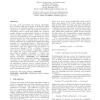Free Online Productivity Tools
i2Speak
i2Symbol
i2OCR
iTex2Img
iWeb2Print
iWeb2Shot
i2Type
iPdf2Split
iPdf2Merge
i2Bopomofo
i2Arabic
i2Style
i2Image
i2PDF
iLatex2Rtf
Sci2ools
AUSDM
2007
Springer
2007
Springer
SemGrAM - Integrating Semantic Graphs into Association Rule Mining
To date, most association rule mining algorithms have assumed that the domains of items are either discrete or, in a limited number of cases, hierarchical, categorical or linear. This constrains the search for interesting rules to those that satisfy the specified quality metrics as independent values or as higher level concepts of those values. However, in many cases the determination of a single hierarchy is not practicable and, for many datasets, an item’s value may be taken from a domain that is more conveniently structured as a graph with weights indicating semantic (or conceptual) distance. Research in the development of algorithms that generate disjunctive association rules has allowed the production of rules such as Radios ∨ TV s → Cables. In many cases there is little semantic relationship between the disjunctive terms and arguably less readable rules such as Radios ∨ Tuesday → Cables can result. This paper describes two association rule mining algorithms, SemGrAMG ...
| Added | 07 Jun 2010 |
| Updated | 07 Jun 2010 |
| Type | Conference |
| Year | 2007 |
| Where | AUSDM |
| Authors | John F. Roddick, Peter Fule |
Comments (0)

